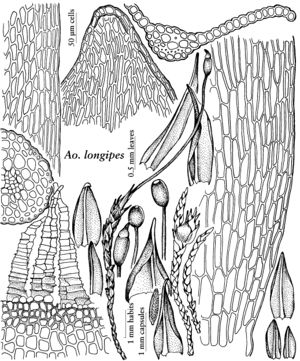Aongstroemia
Bryol. Europ. 1: 171. 1846 ,.
| Taxon | Illustrator ⠉ | |
|---|---|---|
 | Aongstroemia longipes | Patricia M. Eckel |
Plants small, gregarious or in loose thin mats or tufts, yellowish green, orange-red to brown-green, rather dull. Stems erect, 3–6 (–12) mm, simple or occasionally forked, central strand present; scarcely radiculose, rhizoids red, smooth. Leaves ovate or shortly lanceolate-acuminate, concave proximally, tubulose when acuminate, erect and appressed-imbricate when dry, somewhat loosely so when moist; apices in proximal leaves broadly acute grading to obtuse to acuminate-subulate in distal leaves; margins plane to incurved, entire, notched at the apex; costa prominent, single, ending before the apex, smooth on all surfaces, guide cells in 1 row, stereid bands 2, the adaxial band reduced, abaxial and adaxial epidermis prominent; laminal cells convex in section, without pits, smooth, mostly elongate throughout, shorter in the apex, walls in surface view thick-walled, irregularly elongate-hexagonal, rhomboid or rectangular, alar cells undifferentiated. Specialized asexual reproduction absent. Sexual condition dioicous; perigonial plants similar to the perichaetial, perigonium terminal, conspicuous, perigonial leaves larger than the cauline leaves, broadly lanceolate-triangular with an abrupt acumination, broadly tubulose; perichaetium terminal, conspicuous, leaves larger than stem-leaves, convolute-sheathing, abruptly long-acuminate to subulate. Seta elongate, smooth, erect, yellow-orange to red. Capsule erect, globose, ovate or short-cylindric, straight, symmetric, smooth wet or dry, annular cells weakly differentiated in one layer; operculum conic to short-rostrate, oblique; peristome variably absent or present, single, 16 teeth ± cleft to 1/2 the length, vertically pitted-striolate basally, weakly papillose to smooth distally, reddish-brown to nearly hyaline. Calyptra cucullate, smooth, naked, fugacious. Spores 12–20 µm, smooth to finely papillose.
Distribution
North America, Mexico, Central America, South America, Eurasia, Atlantic Islands
Discussion
Species 7 (1 in the flora).
The highest diversity for Aongstroemia is in Mexico, Central America, and South America.
Selected References
None.
Lower Taxa
"/2" is not declared as a valid unit of measurement for this property.